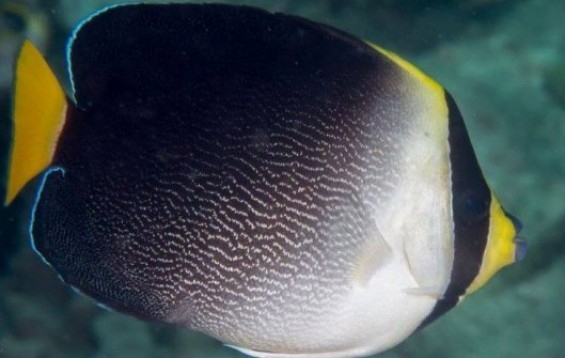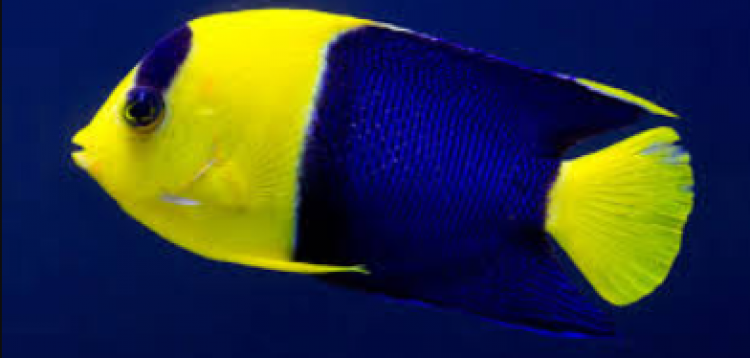- Name:
Vermiculated Angelfish
(View AKA's) - Family: Pomacanthidae
- Species: Angel Large
- Scientific Name: Chaetodontoplus mesoleucus


General info about Vermiculated Angelfish
The Singapore Angelfish has been likened to a butterflyfish in body structure. Blue lips and a yellow nose abruptly change to a black vertical band over the eyes, resembling a mask. The mask is bordered with another thin vertical band of yellow, followed by a wider vertical band of white with the body being primarily black. Dorsal and anal fins are outlined in brilliant sapphire-blue and the caudal fin is usually yellow but may be gray. The Singapore Angelfish can be challenging to keep. Some acclimate well, while others hide constantly and do not eat. Providing a quietly located aquarium with non-aggressive tank mates and plenty of hiding places may help. A large tank with live rock for grazing will also help provide an optimal environment. The Singapore Angelfish is prone to nip at stony and soft corals (sessile invertebrates) and clam mantles. It will also graze on microalgae, filamentous algae, and diatoms.
Vermiculated Angelfish Diet & Nutrition
The Singapore Angelfish are omnivores that feed primarily on benthic algae and seaweed but is also observed to feed on sponges, tunicates, and filamentous algae. In the tank, these angels may be fed with a mix of meaty and pelletized food. Diet should consist of prepared food with Spirulina content, and meaty fare such as mysis shrimp and shredded fresh or frozen shrimp. They may also be fed with filamentous algae and diatoms.
Determining Sex of Vermiculated Angelfish
There are no determining morphological characteristics for this species. However, like other angelfish, it is usually the larger sized individuals that turns out to be male.
Breeding & Spawning Vermiculated Angelfish
Not yet bred in captivity, however in the wild, the Vermiculated Angelfish starts courtship just before sunset. The male will swim above the female, tilts his body and extends his fins, awaiting for a response from the female. When ready, the female will swim towards the area which the male designated as their spawning area. The pair will then soar above the water column as the male nuzzles the female belly. Simultaneously, both will release their gametes into the water column for fertilization.
Common Diseases with Vermiculated Angelfish
They are highly susceptible to Marine Ich (Cryptocaryon irritans) when stressed by other fish, bad water quality, or when relocated. Symptoms consists of constant scratching which ends to lots of white dots. The dots may disappear for a couple of days only to return with double the number. This will then lead to the suffocation of the fish caused by the parasites blocking the gills from providing oxygen.
It may also contract a viral infection, Lymphocystis, which are small cauliflower-shaped nodules in the fins and mouth, which may prevent it from eating for a prolonged period of time.
Vermiculated Angelfish Origin
The Vermiculated angelfish are widely distributed in the Indo-West Pacific region ranging from Japan to Indonesia, Sri Lanka and east to Papua New Guinea and also reported to be seen in Mentawai Island.
Caution with Vermiculated Angelfish
This species are known to eat tubeworms and may nibble on clam mantles. These angels aren't the most aggressive animal in their family, but they still don't like other fish that are the same size and shape.
They may be housed with peaceful and semi-aggressive fishes like cardinalfish, gobies, tilefish, damselfish, butterflyfish, fairy basslets, and wrasses.
Acclimating Vermiculated Angelfish
Tank conditions must be kept pristine at all times. The Vermiculate angelfish should be kept in tanks with a minimum size of 100 gallons with plenty of live rocks and algae. They acclimate best when introduced in tanks as juveniles. To encourage feeding, the fish may be presented with caulerpa or a freshly opened clam or mussel or live feeder mysis or brine shrimp to initiate a feeding response. Keeping the tank area quiet is also important to encourage the angelfish to come out to feed.
Original Detail
| Name | Species | Family | Scientific Name | More Detail | Added by |
|---|---|---|---|---|---|
| Vermiculated Angelfish | Angel Large | Pomacanthidae | Chaetodontoplus mesoleucus | The Singapore Angelfish has been likened to a butterflyfish in body structure. Blue lips and a yellow nose abruptly change to a black vertical band over the eyes, resembling a mask. The mask is bordered with another thin vertical band of yellow, followed by a wider vertical band of white with the body being primarily black. Dorsal and anal fins are outlined in brilliant sapphire-blue and the caudal fin is usually yellow but may be gray. The Singapore Angelfish can be challenging to keep. Some acclimate well, while others hide constantly and do not eat. Providing a quietly located aquarium with non-aggressive tank mates and plenty of hiding places may help. A large tank with live rock for grazing will also help provide an optimal environment. The Singapore Angelfish is prone to nip at stony and soft corals (sessile invertebrates) and clam mantles. It will also graze on microalgae, filamentous algae, and diatoms. |
PalaciosAn |


